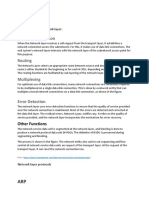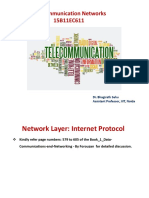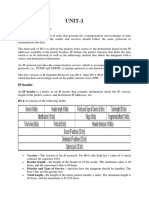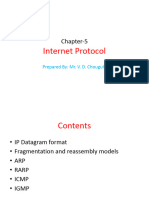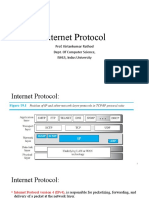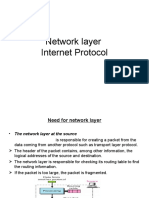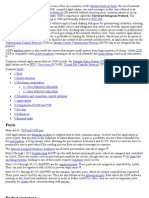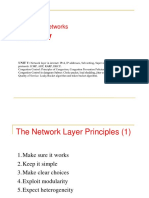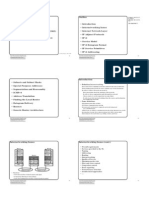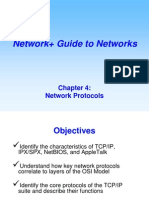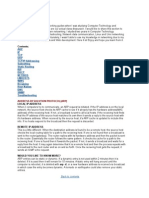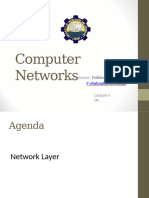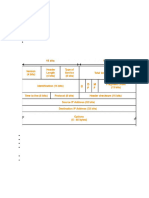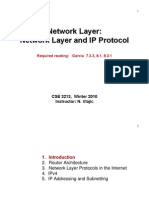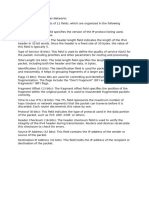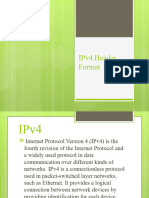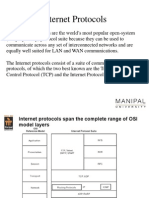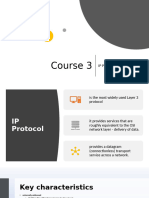Ipv4 Internet Protocol (Ip)
Ipv4 Internet Protocol (Ip)
Uploaded by
sunnys45Copyright:
Available Formats
Ipv4 Internet Protocol (Ip)
Ipv4 Internet Protocol (Ip)
Uploaded by
sunnys45Original Description:
Original Title
Copyright
Available Formats
Share this document
Did you find this document useful?
Is this content inappropriate?
Copyright:
Available Formats
Ipv4 Internet Protocol (Ip)
Ipv4 Internet Protocol (Ip)
Uploaded by
sunnys45Copyright:
Available Formats
2/6/2015
Internet Protocol (IP)
IPv4 (Internet Protocol version 4)
Internet Protocol is layer three protocol used to identify host ,
intermediate devices and different networks uniquely all over the
world during packet transmission.
Need of Network layer addressing ?
IPv4
Allocation techniques
IPv4 header
OPM
The internet layer facilitates internetworking, which is the concept of
connecting
i multiple
l i l networks
k with
i h eachh other
h through
h
h networkk
gateways.
OPM
Core protocols of IP layer
Basic functions of Internet layer
Internet protocol implemented in form of IPv4 and IPv6.
For outgoing packets, select the next-hop device (router or
gateway) and transmit the packet to link layer.
For incoming packets, capture packets and pass the packet payload
to the appropriate transport-layer protocol.
The Internet Control Message Protocol (ICMP) is primarily used
for error and diagnostic functions of a network. Different
implementations exist for IPv4 and IPv6.
The Internet Group Management Protocol (IGMP) is used by IPv4
hosts and adjacent multicast routers to establish multicast group
memberships.
In addition it provides error detection in network and diagnostic
capability (ICMP).
Internet Protocol Security (IPsec) is a suite of protocols for
securing Internet Protocol (IP) communications by authenticating
and/or encrypting each IP packet in a data stream. IPsec also
includes protocols for cryptographic key establishment
OPM
OPM
IPv4
IPv4 (cont.)
IPv4 was described in RFC 791 (September 1981).
IPv4 uses 32 bits addresses, which limits the address space
to 4294967296 (232) addresses.
IPv4 is a connectionless protocol for use on Packet switched
networks.
IPv4 address exhaustion (occurred on February 3, 2011)
significantly delayed by following addressing changes such as
It operates on a best effort service model, in that it does not
guarantee delivery, nor does it assure proper sequencing or
avoidance of duplicate delivery. These aspects are addressed by
an transport protocol, such as TCP and UDP.
OPM
Classful network design,
Classless network design (Classless Inter Domain Routing CIDR),
Network Address Translation (NAT).
Dynamic Host Configuration Protocol (DHCP)
OPM
2/6/2015
Classful IP allocation Technique
Dotted-decimal notation and binary notation for an IPv4 address
OPM
OPM
Netid and hostid
Number of blocks and block size in classful IPv4 addressing
OPM
OPM
10
Each IP address contains information of Network & Host number
Classless IP allocation Technique (CIDR)
The leftmost n bits (prefix) define the network Number.
The total number of Networks in the block can be found by using the formula 2n.
The rightmost 32 n bits define the host number.
InIPv4addressing,ablockof
addressescanbedefinedas
x.y.z.t /n
/
inwhichx.y.z.t definesoneoftheaddressesandthe/n definesthemask.
OPM
The total number of host addresses in the block can be found byy usingg the
formula 232n.
11
OPM
12
2/6/2015
Configuration and addresses in a subnetted network
OPM
Three-level hierarchy in an IPv4 address
13
NAT implementation
OPM
14
OPM
16
Addresses in a NAT
OPM
15
NAT address translation
Example: Five-column translation table
OPM
17
OPM
18
2/6/2015
Some special address blocks
Private Network IP address
The following three blocks of IP addresses are reserved for use in private networks.
These IP addresses are not routable outside of private networks, and private
machines cannot directly communicate with public networks.
They can, however, do so through network address translation (NAT).
Link-local addressing
special address block 169.254.0.0/16 for link-local addressing, only valid on
links connected to a host . These addresses are not routable so cannot be the source
or destination of packets traversing the internet (public network). These addresses
are primarily used when a host cannot obtain an IP address from a DHCP server or
other internal configuration methods.
Loopback
The class A network 127.0.0.0 (classless network 127.0.0.0/8) is reserved for
l
loopback.
b k IP packets
k t with
ith source addresses
dd
belong
b l
to
t this
thi network
t
k never appear
outside a host.
IP packets with source and destination addresses belong to the network (or
subnetwork) of the same loopback interface are returned back to that interface,
hence can be used to check network interface port of a host device.
OPM
19
Addresses ending in 0 or 255
Class C networks in classful networking, and networks with CIDR prefixes /24
to /32 (255.255.255.0255.255.255.255) can not have an address ending in 0 or
255.
OPM
20
In networks except class C, the IP addresses
ending with 0 and 255 can be used.
IP Datagram Format (with header)
bit # 0
7 8
version
header
length
15 16
ECN
DS
Identification
time-to-live (TTL)
23
24
IPv4 header fields
31
Version:- 4 bits field, for IPv4 field value is 4 .
total length (in bytes)
0
D M
F F
protocol
Fragment offset
IHL (Internet Header Length):- 4 bits field, which is the number of
32-bit word in the header. this field specifies the size of the header
(this also coincides with the offset to the data).
data) The minimum value
for this field is 5 (RFC 791), which is a length of 532 = 160 bits =
20 bytes. Being a 4-bit value, the maximum length is 15 words
(1532 bits) or 480 bits = 60 bytes.
header checksum
source IP address
destination IP address
options (0 to 40 bytes)
payload
4 bytes
20 bytes Header Size < 24 x 4 bytes = 60 bytes
20 bytes Total Length < 216 bytes = 65535 bytes
OPM
21
OPM
IPv4 header fields (cont.)
22
IPv4 header fields (cont.)
Type of Service (originally defined ):- 8-bits field
DifferentiatedServices(DS 6bitsdefines type of services like control, data,
real-time streaming etc.
ExplicitCongestionNotification(ECN2bits allowsendtoendnotification
ofnetworkcongestion withoutdroppingpackets).
Total length : 16-bits field defines the entire packet (fragment) size, including header
and data, in bytes (octet).
The minimum-length packet is 20 bytes (20-byte header + 0 bytes
data) and the maximum is 65,535 bytes the maximum value of a 16bit word.
Identification : uniquely identifies a datagram or must be copied in fragments.
Retransmission of a packet carries the same identification number.
Some experimental work has suggested using the ID field for other
purposes, such as for adding packet-tracing information to help trace
datagrams with spoofed source addresses
OPM
23
OPM
24
2/6/2015
IPv4 header fields (cont.)
IPv4 header fields (cont.)
Flags:- 3-bits field,
used to control or identify fragments. They are (in order, from high order to
low order).
bit 0: Reserved; must be zero.
bit 1: Don't Fragment (DF), set (1) for dont fragment, clear (0) for fragment
bit 2: More Fragments (MF), set (1) for more fragment follows, clear (0) for
no fragment and last fragment.
fragment
Fragment Offset:- 13-bits long field,
measured in units of eight-byte blocks,
specifies the offset of a particular fragment relative to the beginning of the
original un-fragmented IP datagram.
The first fragment has an offset of zero. This allows a maximum offset of
(213 1) 8 = 65,528 bytes, which would exceed the maximum IP packet
length of 65,535 bytes with the header length included (65,528 + 20 = 65,548
bytes).
OPM
Th
The field
fi ld has
h become
b
a hop-countwhen
h
t
h the
th datagram
d t
arrives
i
att a router,
t the
th
router decrements the TTL field by one.
When the TTL field hits zero, the router discards the packet and typically
sends a ICMP time exceeded message to the sender.
The program traceroute uses these ICMP Time Exceeded messages to print
the routers used by packets to go from the source to the destination.
OPM
26
IPv4 header fields (cont.)
Protocol :- 8-bit field
Source address:-
This field defines the protocol (TCP or UDP) used in the data portion of the
IP datagram.
Checksum :- 16-bit field (checksum of 16-bit blocks)
used for error
error-check
check of the header
header.
OPM
27
IPv4 header fields (cont.)
OPM
28
Sender can put any source address in packets he sends:
Can be used to send undesired return traffic to the spoofed address
Can be used to bypass filters to send undesired traffic to the destination
Option Number (5 bits)
OptionNumber(5bits)
Copy : Set to 1 if the options need to be copied into all fragments of a fragmented packet.
Option Class : options category. 0 is for datagram or network control" options, and 2 is
for "debugging and measurement". 1, and 3 are reserved.
Option Number : value 0 for end of option list, 3 for loose source route, 7 for record
route, 9 for strict source route, 11 for MTU probe, 18 for traceroute program to find
routers along a path etc.
OPM
This field is the IPv4 address of the receiver of the packet
packet. As with the
source address, this may be changed in transit by a Network Address
Translation device.
Address spoofing
Options: The options field is not often used.
The list of options may be terminated with an EOL (End Of Option list, 0x00)
option; this is only necessary if there is any option entries in header.
The possible options that can be put in the header are as follows:
Option class (2 bits)
Optionclass(2bits)
This field is the IPv4 address of the sender of the packet. This address may
be changed in transit by a Network Address Translation device.
Destination address:-
Checksum is calculated as 1s complement of sum of 1s complement of all
16-bit blocks of IP header.
When a packet arrives at a router, the router calculates the checksum of the
header and compares it to the checksum field. If the values do not match, the
router discards the packet.
Errors in the data field must be handled by the encapsulated protocol.
When a packet arrives at a router, the router decreases the TTL field.
Consequently, the router must calculate a new checksum.
Copy (1 bit)
Copy(1bit)
helps prevent datagram from persisting (e.g. going in circles) on an internet.
This field limits a datagram's lifetime.
25
IPv4 header fields (cont.)
Time To Live (TTL):- 8-bits field
29
Reverse Path verification can be used by routers to broadly
catch some spoofers using option field.
OPM
30
2/6/2015
Basic IPv4 Routing
Fragmentation
Static routing. Used by hosts and some firewalls and routers.
May need to fragment an IP packet if one data link along the way
cannot handle the packet size
Perhaps path is a mix of different Hardwares.
Perhaps unexpected encapsulation makes the packet larger than the source
expected
Hosts try to understand Maximum Transmission Unit (MTU) to avoid the
need
d for
f fragmentation
f
t ti (which
( hi h causes a performance
f
hit)
Identification field identifies all elements of the same fragment
Fragmentation stored in the MF (more fragments) and fragment offset fields
Devices can reassemble too
But generally the destination does the reassembly
OPM
31
Networks gateways, Next hop addresses, other routers information etc.
May have routing table per incoming interface
To route a packet, take the destination address and find the best match
network in the table
table. In case of a tie look at the metric
Any device along the way can fragment (in IPv4 only)
Routing table consists of entries of
Use the corresponding next hop address and interface to send the packet on.
The next hop address is on the same link as this device, so you use the next
hops data-link address, e.g. ethernet MAC address
Decrement time to live field in IP header at each hop. Drop packet when
it reaches 0
Attempt to avoid routing loops
TTL fields maximum value is 255.
OPM
32
Dynamic Routing Protocols
Source Based Routing
In the IP Options field, can specify a source route
Was conceived of as a way to ensure some traffic could be delivered through
predefined path irrespective of routing tables.
Can be used by the network attacker to avoid security enforcing
devices
For scaling, discover topology and routing rather than
statically constructing routing tables
Open Shortest Path First (OSPF): Used for routing within an
administrative domain
Traffic diversion by considering current status of a particular path
Border Gateway Protocol (BGP): Used for routing between
administrative domains.
OPM
33
OPM
34
You might also like
- The Bits and Bytes of Computer NetworkingDocument55 pagesThe Bits and Bytes of Computer NetworkingAravind Dhananjeyan83% (6)
- TCP IpDocument55 pagesTCP IpKhổ TâmNo ratings yet
- 7 Network Layer IPv4Document33 pages7 Network Layer IPv4raj25comNo ratings yet
- Ipv4 Was Described in (September 1981) - Ipv4 Is A For: Connectionless Protocol Use On Packet Switched NetworksDocument26 pagesIpv4 Was Described in (September 1981) - Ipv4 Is A For: Connectionless Protocol Use On Packet Switched NetworksSigra JisawNo ratings yet
- NetworkingDocument12 pagesNetworkingRahul singh bishtNo ratings yet
- Internet _ ProtocolDocument15 pagesInternet _ ProtocolzensjbqdnltiawalywNo ratings yet
- Telecommunication Networks 15B11EC611: Dr. Bhagirath Sahu Assistant Professor, JIIT, NoidaDocument29 pagesTelecommunication Networks 15B11EC611: Dr. Bhagirath Sahu Assistant Professor, JIIT, NoidaMOHAMMED FAYEZ KHANNo ratings yet
- Lecture03 Network Layer Internet ProtocolDocument24 pagesLecture03 Network Layer Internet Protocolabdullahabushehab14No ratings yet
- Unit-1 (Part 1) PDFDocument36 pagesUnit-1 (Part 1) PDFPranjal NagarNo ratings yet
- Unit - 3Document114 pagesUnit - 3PradnyaNo ratings yet
- Internetworking and IPDocument34 pagesInternetworking and IPRakshanda SavarnyaNo ratings yet
- Chapter5 Internet ProtocolDocument58 pagesChapter5 Internet ProtocolHarshad ShelkeNo ratings yet
- Internet Protocol: Prof. Kirtankumar Rathod Dept. of Computer Science, ISHLS, Indus UniversityDocument51 pagesInternet Protocol: Prof. Kirtankumar Rathod Dept. of Computer Science, ISHLS, Indus Universitykirtan71No ratings yet
- Logical Addreessing CNDocument100 pagesLogical Addreessing CNRohan singhNo ratings yet
- Ch4.G CN Network LayerDocument38 pagesCh4.G CN Network LayerAakrit DongolNo ratings yet
- Unit4 2 2019-20Document41 pagesUnit4 2 2019-20Siddhartha OntelaNo ratings yet
- Network Layer Internet ProtocolDocument23 pagesNetwork Layer Internet ProtocolCh Saqib ShabbirNo ratings yet
- CN 2 & 3rd UnitDocument18 pagesCN 2 & 3rd UnitannamyemNo ratings yet
- Unit V C ProtocolsDocument61 pagesUnit V C ProtocolsPiush GogiNo ratings yet
- DR Shahedur Rahman: Computer Networks, Wireless and Mobile CommunicationsDocument36 pagesDR Shahedur Rahman: Computer Networks, Wireless and Mobile CommunicationsdkhanNo ratings yet
- IPV6Document12 pagesIPV6Sathish ShettyNo ratings yet
- Module07 Ipv2Document21 pagesModule07 Ipv2Prasanna Kumar DasNo ratings yet
- The User Datagram ProtocolDocument5 pagesThe User Datagram ProtocolDeirre McKeeNo ratings yet
- Unit 5 IPv6Document11 pagesUnit 5 IPv6Dudzayi KasiyoNo ratings yet
- Unit IDocument172 pagesUnit IPraveen SaravananNo ratings yet
- Raw SocketsDocument13 pagesRaw SocketsmOrtyyNo ratings yet
- Ebooks - 12 IS-W3D2-SCR200309121203031818Document12 pagesEbooks - 12 IS-W3D2-SCR200309121203031818shubham sahaiNo ratings yet
- Advanced Computer Networks Practical FileDocument32 pagesAdvanced Computer Networks Practical Filelali6580% (5)
- Cis81 E1 5 NetworkLayerDocument42 pagesCis81 E1 5 NetworkLayerEwa LisekNo ratings yet
- Bits and Bytes of Computer Networking Week 2 2Document5 pagesBits and Bytes of Computer Networking Week 2 2George HernandezNo ratings yet
- Network Programming BTCS703: TCP & IP HeadersDocument3 pagesNetwork Programming BTCS703: TCP & IP HeadersvivekkumarsNo ratings yet
- Packet Formats To RememberDocument18 pagesPacket Formats To RememberVansh MalikNo ratings yet
- How The TCP/IP Protocol Works: Les Cottrell - SLACDocument49 pagesHow The TCP/IP Protocol Works: Les Cottrell - SLACgoons7777No ratings yet
- Unit - V: Computer NetworksDocument108 pagesUnit - V: Computer NetworksNAMAN JAISWALNo ratings yet
- Internetworking With TCP/IP (ETC003) : © Adrian Popescu, 2003, 2004Document5 pagesInternetworking With TCP/IP (ETC003) : © Adrian Popescu, 2003, 2004Rohit KshirsagarNo ratings yet
- Network+ Guide To NetworksDocument67 pagesNetwork+ Guide To NetworksSamin AfnanNo ratings yet
- TCP IpDocument22 pagesTCP IpCentaur ArcherNo ratings yet
- NotaDocument29 pagesNotaJavier Soto LedezmaNo ratings yet
- The Internet NotesDocument91 pagesThe Internet NotesTejas Raghavendra Bhat MNo ratings yet
- Lecture #4 ThrDocument80 pagesLecture #4 Thrmalaikasmjad163No ratings yet
- Unit 3Document28 pagesUnit 322r11a05t5No ratings yet
- Ccna Class 3Document135 pagesCcna Class 3ntimamaoNo ratings yet
- 6976 TDMoIPBackgrounderDocument9 pages6976 TDMoIPBackgrounderfonpereiraNo ratings yet
- Unit III Day 1Document22 pagesUnit III Day 1Pavan ParthikNo ratings yet
- Ipv4 Packet Header: Lecture No6Document6 pagesIpv4 Packet Header: Lecture No6Group BNo ratings yet
- CSE3213 17 NetLayer IP F2010Document33 pagesCSE3213 17 NetLayer IP F2010ihsan1No ratings yet
- cnDocument4 pagescnArjun BansalNo ratings yet
- 2.2 Giới thiệu lớp mạngDocument31 pages2.2 Giới thiệu lớp mạngDũng PhạmNo ratings yet
- Unit-4Document66 pagesUnit-4say.talekarNo ratings yet
- Navdeep, IPv4 Header FormatDocument11 pagesNavdeep, IPv4 Header Formatkaransharma17200No ratings yet
- Computer Communication Networks CS-418: Lecture 8 - 1 Network Layer - Routing ProtocolsDocument19 pagesComputer Communication Networks CS-418: Lecture 8 - 1 Network Layer - Routing ProtocolsAli MemonNo ratings yet
- InternetDocument60 pagesInternetoureducation.inNo ratings yet
- CN UNIT 2Document114 pagesCN UNIT 2gyisadiyaNo ratings yet
- Internet ProtocolDocument120 pagesInternet Protocoldeepsj1988100% (1)
- Network ProtocolsDocument34 pagesNetwork ProtocolsWayneNo ratings yet
- Lecture3 Network LayerDocument48 pagesLecture3 Network LayerReymar VenturaNo ratings yet
- Curs 3Document47 pagesCurs 3Zaha GeorgeNo ratings yet
- Network Layer - IP - MukeshDocument19 pagesNetwork Layer - IP - MukeshMukesh100% (2)
- I.P. Protocol AND Network Applications: Authors Mayur Patel Jitendra ShishangiyaDocument29 pagesI.P. Protocol AND Network Applications: Authors Mayur Patel Jitendra ShishangiyablueNo ratings yet
- Cisco Certified Network Associate (CCNA) and Cisco Certified Network Professional (CCNP): Mastering Network Automation and Programmability Study GuideFrom EverandCisco Certified Network Associate (CCNA) and Cisco Certified Network Professional (CCNP): Mastering Network Automation and Programmability Study GuideNo ratings yet




